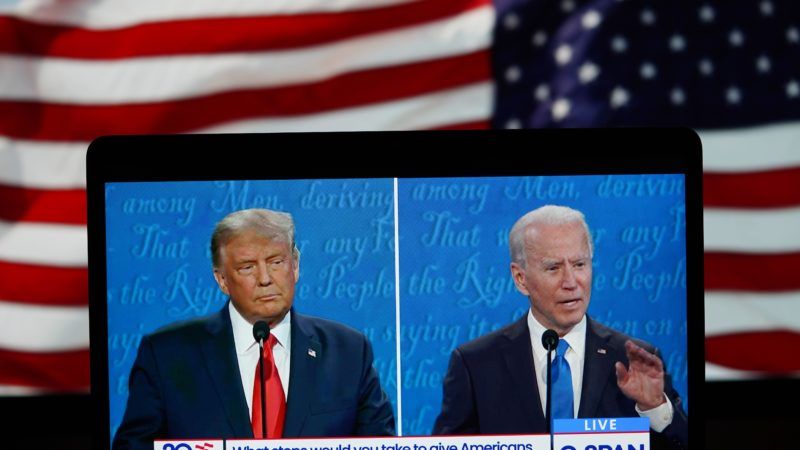Trump and Biden Are Both Misleading Us About COVID-19
The president claims success based on a completely implausible worst-case scenario, while his opponent projects more than 3,700 deaths a day.

During last night's presidential debate, President Donald Trump implied that his response to the COVID-19 pandemic saved 2 million or so lives. "As you know, 2.2 million people, modeled out, were expected to die," he said. "We closed up the greatest economy in the world in order to fight this horrible disease." Trump also mentioned "what we've done in terms of goggles and masks and gowns and everything else, and in particular ventilators." Thanks to these policies, he said, "we're rounding the corner," and "it's going away."
The recent rise in newly identified COVID-19 cases—which exceeded 74,000 nationwide yesterday, according to Worldometer's count—suggests the virus is not in fact "going away." And given the Trump administration's disastrous handling of the virus tests that were crucial to curtailing the epidemic in its early stages, the notion that the president deserves any credit for reducing COVID-19's impact—let alone for saving "millions" of lives, as Republicans claim—is debatable, to say the least. So is the idea that he was responsible for the lockdowns that all but a few states imposed last spring. Even if you think those lockdowns had an important impact on COVID-19 mortality, the decision to impose them was made by governors, not by Trump.
Still, there is a big difference between the current tally of 223,000 deaths and the 2.2 million that Trump says were "expected." Doesn't that contrast suggest he did something right? Only if you think that worst-case scenario was at all plausible to begin with, which it wasn't.
That projection, which Trump embraced at the end of March, was based on a counterfactual "no intervention" scenario that assumed Americans would carry on as usual in the face of the epidemic. That was demonstrably not true, since individuals and businesses were already responding to the threat posed by the virus through voluntary precautions such as limiting travel, avoiding crowds, reducing social interaction, working at home, and canceling events. The projection also assumed an infection fatality rate higher than the current "best estimate" from the Centers for Disease Control and Prevention (CDC).
Both of those assumptions were clearly dubious at the time. But projecting millions of COVID-19 deaths in the United States—which would make the disease as lethal as the Spanish flu of 1918, even after taking population growth into account—had two advantages. It scared Americans into accepting sweeping restrictions on social and economic activity with no precedent in U.S. history, and it allowed politicians like Trump to take credit for the difference between reality and the fantasy that was "modeled out."
Democratic nominee Joe Biden, even while presenting himself as a sober, scientifically informed alternative to a feckless, irrationally optimistic president, engaged in similar scare tactics last night. "The expectation is we'll have another 200,000 Americans dead between now and the end of the year," he said. "If we just wore these masks, the president's own advisers have told him, we can save 100,000 lives."
The current U.S. death toll, according to the Johns Hopkins Coronavirus Resource Center, is about 223,000. Hence Biden, who made a similar claim during his first debate with Trump, is predicting that the number will nearly double by January 1. Is that plausible?
While the seven-day average of newly confirmed cases in the United States has been rising since mid-September, daily deaths so far have risen only slightly. Given the lag between laboratory confirmation and death, we can expect to see a bigger increase in fatalities during the next few weeks. But judging from the experience with this summer's COVID-19 spike, the increase in deaths will not be nearly as large as the increase in cases.
Between June 1 and late July, according to Worldometer's numbers, the seven-day average of daily new cases more than tripled. That was followed by a doubling in the seven-day average of daily deaths between early July and early August, after which the average dropped by 37 percent as of September 8.
The CDC's "ensemble forecast," based on projections from "45 modeling groups," puts the death toll at 235,000 to 247,000 by November 14. Assuming that estimate is in the right ballpark, Biden is projecting at least another 176,000 deaths over six weeks, or more than 3,700 a day, more than four and half times the current seven-day average and two-thirds higher than the peak in April.
That prediction is even less believable than the wildly wrong projection that The New York Times embraced in May, which said daily deaths would exceed 3,000 by June 1. The actual number was about 700.
Biden left himself some wiggle room by suggesting that mask wearing could cut the number of additional deaths by the end of the year in half. But while the weight of the evidence indicates that wearing a mask is a sensible precaution, trying to quantify the impact of that practice is an even more dubious exercise than trying to project COVID-19 deaths. It is not even clear what threshold of mask wearing Biden has in mind, or how he would know whether it had been reached.
Given Trump's record of self-contradiction, equivocation, bizarre medical suggestions, and excessive optimism, I would not trust anything he says about COVID-19. But I do not trust Biden either, since he seems equally willing to treat science as a tool to score political points and promote policies he already supports.


Show Comments (97)